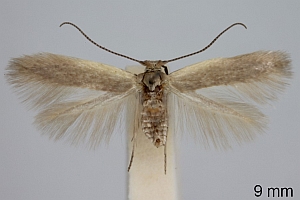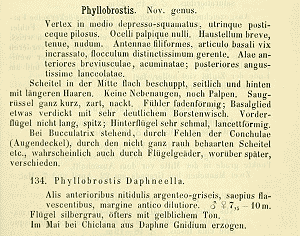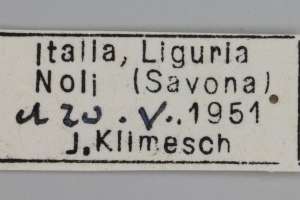

 +9Kontinente:EUAF
+9Kontinente:EUAF2. Diagnose
2.1. Geschlecht nicht bestimmt
2.2. Erstbeschreibung
3. Biologie
3.1. Nahrung der Raupe
- [Thymelaeaceae:] Daphne gnidium (Herbst-Seidelbast)
Mey (2006: 126) schreibt zur Raupennahrung: "Daphne gnidium. Biology. The larvae are leaf-miners. Pupation occurs in silken cocoon spun between leaves or in leaf folds. Adults fly in two generations (April/May and August) in France (Lhomme 1948)." Die Art lebt damit an der gleichen Nahrungspflanze wie P. eremitella.
4. Weitere Informationen
4.1. Faunistik
Mey (2006) untersuchte im Rahmen einer Gattungsrevision sehr viele Museumsbelege dieser Art und schrieb dann zusammenfassend zur Verbreitung: "Morocco [first record], Algeria [first record], Tunisia [first record], Portugal: Algarve (Corley et al. 2000); Spain (Staudinger 1859); France: Alpes-Maritimes, Aude, Charente-Maritime, Hérault, Basses-Pyrénées, Var (Lhomme 1948), Corsica (Baraniak 1996); Italy incl. Sardinia: Aritzo and Tempio (Amsel 1936). Remarks. The specimens from Corsica and Sardinia are often slightly smaller than continental individuals and posses white forewings. The scales on head and thorax are also white. The male genitalia show no differences."
(Autor: Erwin Rennwald)
4.2. Literatur
- Mey, W. (2006): Revision of the genus Phyllobrostis Staudinger, 1859 (Lepidoptera, Lyonetiidae). — Mitteilungen aus dem Museum für Naturkunde Berlin, Deutsche Entomologische Zeitschrift, 53 (1): 114–147. DOI 10.1002/mmnd.200600012.
- Erstbeschreibung: Staudinger, O. (1859): Diagnose nebst kurzen Beschreibungen neuer andalusischer Lepidopteren. — Entomologische Zeitung 20 (7-9): 211-259. Stettin.














